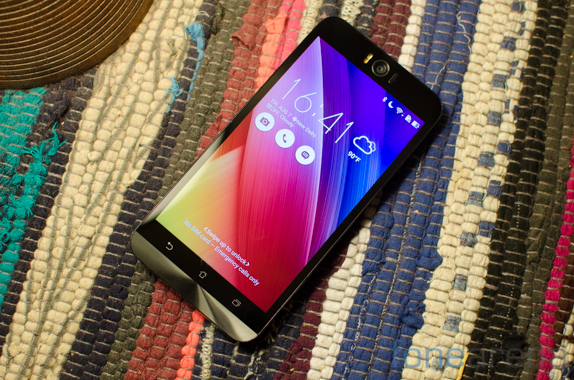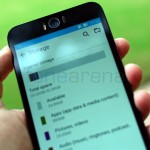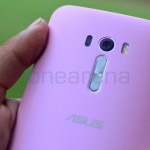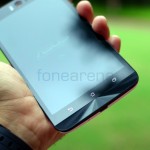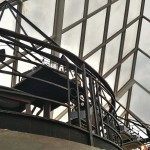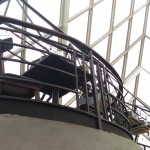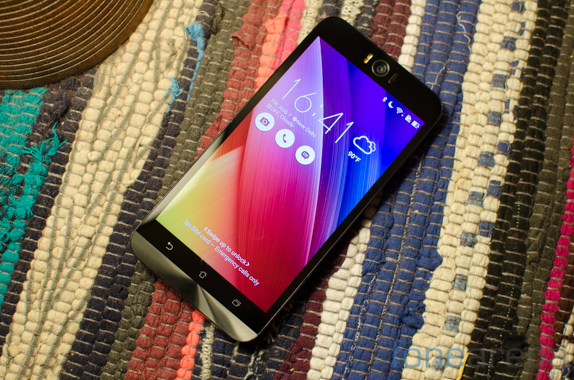
Success begets success seems to be the mantra adopted by Asus as it dramatically ramps up the Zenfone range of handsets on offer. The successful launch of the Zenfone 2 has led to a spate of hardware reveals including the Zenfone 2 Deluxe, Selfie, Laser and Max variants. Invariably, we expect the company to have a couple more up their sleeve before the launch of the Zenfone 3 next year. Today though, we are going to talk about the Zenfone Selfie. A device that strives to succeed in a category where the competition is limited and generally priced much higher. A device that capitalizes on the latest social trends, a trend that certainly isn’t showing any signs of waning. A device focused on photography both from the rear camera and more importantly in this context, the front camera. This is the FoneArena review of the Zenfone 2 Selfie.
Design
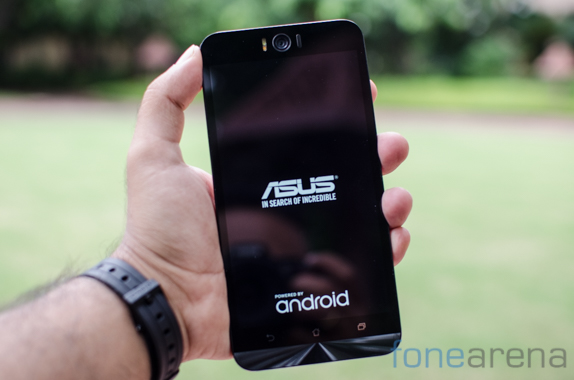
Being based on the Zenfone 2 platform, there’s little to differentiate the two devices at first glance. Indeed, instead of regurgitating the original Zenfone 2 review, we will focus more on the differences between the devices.
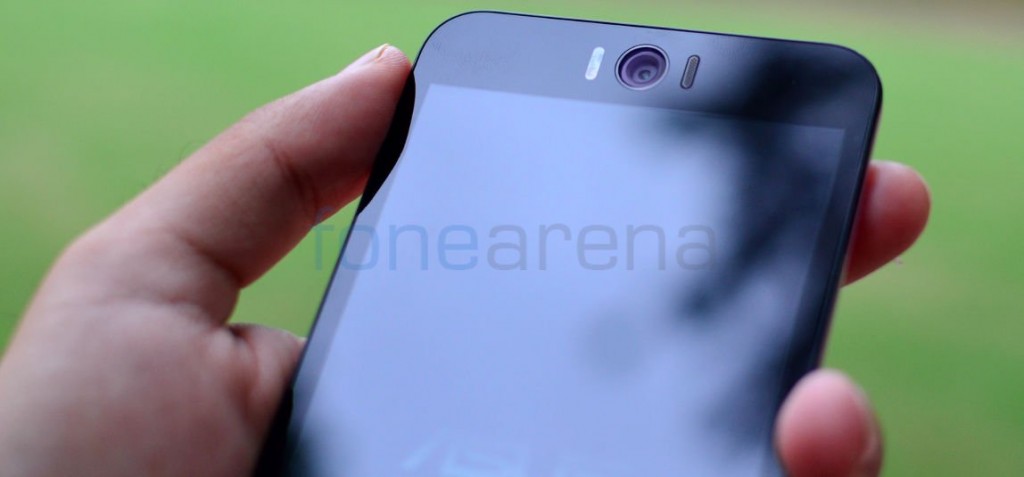
The Zenfone 2 Selfie sits taller than the original Zenfone 2. Above and below the 5.5-inch display are bezels that are marginally larger here. Below the screen you’ll spot three capacitive buttons under which is a brushed aluminum plate. A design feature that has carried on from the first generation Zenfone and looks equally good here. Above the screen though is a camera unit that gapes through like the eye of a cyclops. Paired with a dual tone flash unit, it makes for a look that is more utilitarian than beautiful.
In the same vein as the Zenfone 2, the device is absolutely bereft of buttons along the left and right edges. You’ll spot the power button up top with a 3.5mm audio jack for company. The microUSB charging and data port is at the bottom. Turn the phone around and you’ll notice that the volume rocker has been placed as a strip that lies below the camera module. Fairly easy to reach out once you get some practice, the rear placement makes it easier to change volume and also allows the company to make the edges of the phone thinner.
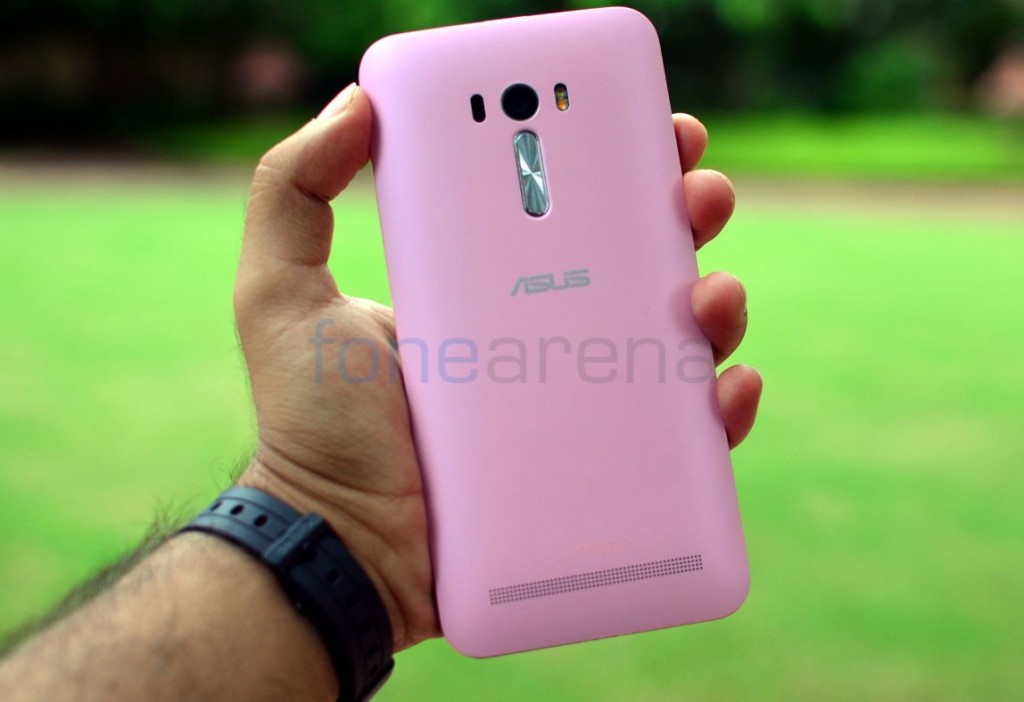
Measuring 156.5 x 77.2 x 10.8mm, the phone is certainly not petite. The large dimensions can make the the handset a bit unwieldy to hold. Tap to unlock and gestures for activating the camera do help mitigate that to a degree. At 170 grams, even the weight is not something to scoff at. There’s a considerable heft to the handset and not all of it can be passed on as reassuring. The sole benefit here is that the phone certainly does feel very sturdy and should be able to withstand drops and heavy handed usage.
Software
The Zenfone Selfie has software based on Android 5.0.2 with a highly customized interface layer thrown on top. Called Zen UI, it adds a range of features, enhancements and a whole lot of bloatware as well. We’ve already covered the software in-depth in our Zenfone 2 review but here’s a quick refresher on what forms the essence of the software on the Zenfone Selfie.
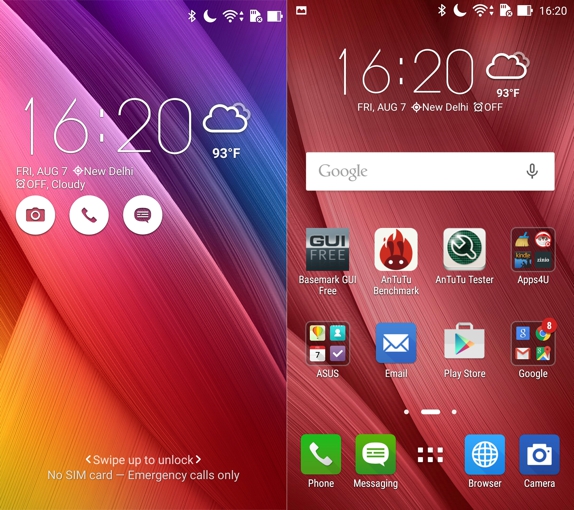
From the lock screen you can launch three applications and get a weather notification in addition to the time. Even with a locked display, you can make gestures to launch specific modes in applications. Case in point, you can draw S to launch the front facing camera while a C will launch the regular camera. Double tap to unlock the phone and up to 7 homescreens can be set up with the default launcher, which offers a regular grid like arrangement of apps that is commonplace. The general interface isn’t very customizable and lacks grid sizes that increase information density.
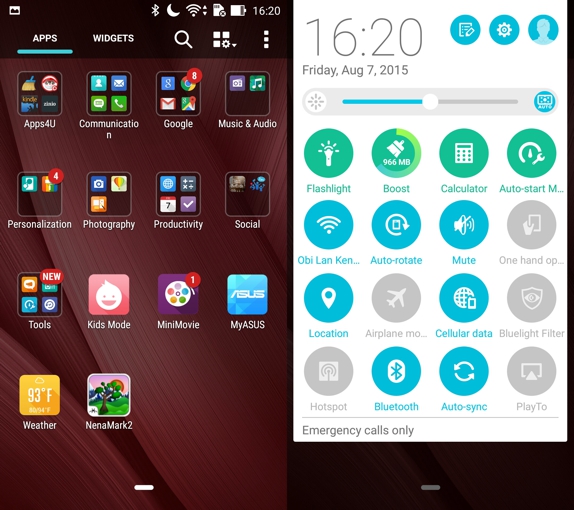
The drop down menu includes customizable quick settings for toggles like smart savings, reading mode. Asus also has a rather interesting What’s Next app that integrates with the drop down notification hub and the lockscreen to offer information about events like birthdays, adverse weather conditions, etc. There’s a whole lot of bloatware installed on the device that is more or less useless. There is a built in utility that helps you control which applications can auto start that comes in handy to keep things speedy all around.
Performance
Unlike the Zenfone 2, there is a rather drastic departure here in terms of under the hood hardware. The Zenfone Selfie is powered by a Snapdragon 615 processor and has 3GB of RAM onboard. Clocked at 1.65Ghz, the octa core processor is fairly capable. The Adreno 405 GPU that it is paired with is unfortunately not all that great for high end gaming and we spotted a fair few dropped frames. This is an issue that has plagued pretty much all Snapdragon 615 powered devices. Heating too is a concern with the phone often hovering around the 35 degree C mark. Not enough to burn your hand but certainly high enough to make you worry for the safety of the hardware. Of the 3GB RAM, there’s about 2.7GB usable and around 1.2GB of free RAM at first boot. The particular SKU that we have has 32GB of built in storage and about 23 GB is available when you first launch the device. Generally speaking, the performance is absolutely serviceable without any slow downs or major issues. Frame rate drops and occasional hiccups were however things that we spotted from time to time during intensive gaming. That said, let’s take a look at some of the benchmark scores.

In the Quadrant benchmark, the Zenfone Selfie tops the charts ahead of the Xiaomi Mi4i. It scores 24685 points.
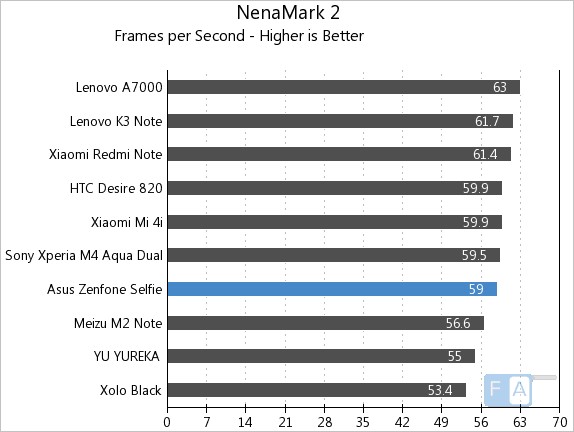
In the GPU centric NenaMark 2 benchmark, the phone manages 59 frames per second which is right in line with the rest of the competition.
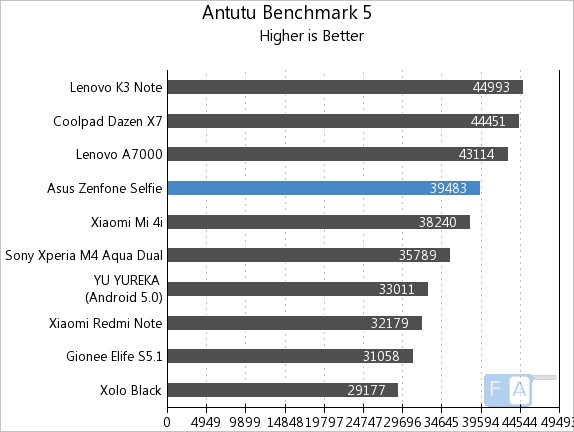
The Asus Zenfone Selfie managed 39483 points in the Antutu benchmark wherein it marginally lags behind the competition.
Display
Like the Zenfone 2, the Zenfone Selfie too is equipped with the same display. A 5.5 inch unit with a resolution of 1920×1080 pixels, it is a very nice panel indeed. The IPS panel in use displayed good viewing angles and excellent contrast levels.
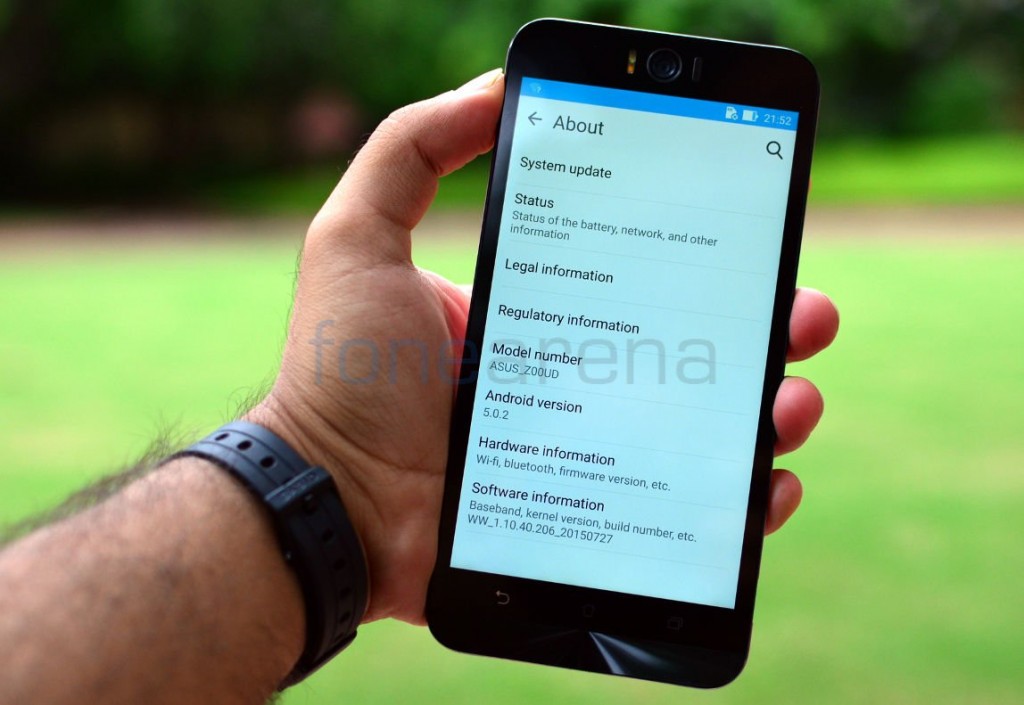
Saturation was good and veered towards natural looking tones. It is possible to marginally tweak the color tones here. In terms of brightness levels, the display is good but there is margin for improvement here. Outdoors in bright sunlight, there are occasions where the reflective nature of the display proves problematic and a brighter screen would’ve solved the issue.
Camera
The Zenfone Selfie is a device that has been geared towards photography enthusiasts and on that note, it comes equipped with not just one but two 13MP cameras. Up front and at the back, you get 13MP camera units that have been paired up with dual LED true tone flash units for more natural looking LED flash lighting. Add to that a laser autofocus unit and things get a lot more interesting.
Let’s talk about the rear facing module first. A 13MP camera with f/2.0 aperture and a laser auto focus module to boot. Images from the camera were generally good though there is fairly aggressive noise reduction at play. The phone boosts up contrast levels and sharpness which certainly shows up when pixel peeping.
On the whole though, images look good enough albeit slightly oversaturated. There’s a litany of modes on offer and they more or less work as expected. In addition the software is smart enough to recognize situations wherein the HDR mode or night mode might be beneficial and handily offers it as a suggestion right on the viewfinder.
The name of the phone however is derived from its front facing camera. The front unit has the same 13MP Toshiba sensor as the rear facing camera and it also packs the same dual tone flash. For better or worse, it brings along the same idiosyncrasies as the rear module including its tendency to generally over-blow highlights. Beyond that, the camera is better than most out there when it comes to shots from the front camera. The wide angle lens also helps in capturing more of the surroundings or a large group if that’s what you are photographing.
Connectivity / Storage / Battery
In terms of connectivity, there is nothing extraordinary on the Zenfone Selfie and it is strictly run of the mill. You get support for 4G LTE / 3G HSPA+, WiFi 802.11 a/b/g/n, Bluetooth 4.0 and GPS. There is 32GB of storage onboard of which around 23GB is available to the end user. It is possible to expand that via the microSD card slot and USB On The Go capabilities mean that you can connect a USB drive as well. Applications can be moved over to the SD card slot as well.
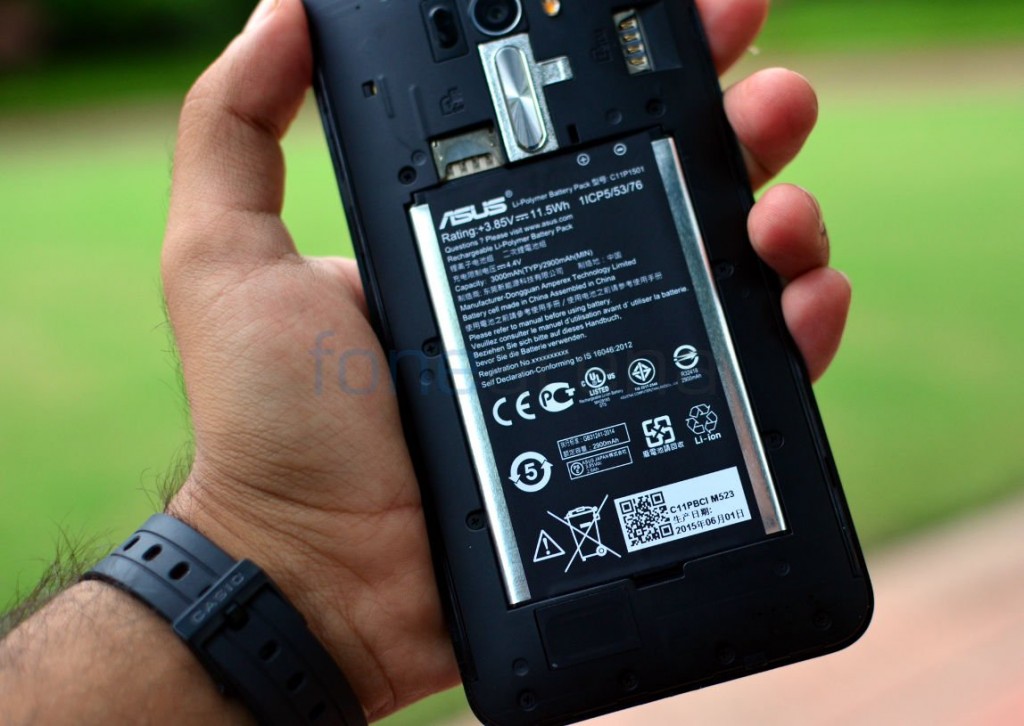
The combination of a 3000mAh battery and a Snapdragon 615 processor means that battery life is decent if not stellar. For what its worth, the Zenfone Selfie certainly outpaces the Zenfone 2 when it comes to standby times and we recorded a drop of about 20% over almost 2 hours of gaming and playing videos. Not bad at all. Invariably, the phone would last a full work day of usage though you will certainly have to charge it overnight.
Conclusion
The Zenfone Selfie enters a market that is flooding with competition. On its own, there’s precious little that separates it or makes it stand out from the competition but the front facing camera can strategically serve as a major USP. While not drastically better than the likes of the Xiaomi Mi4, the front camera certainly does make an improvement to shots. On its own too, the phone is a good enough performer with no standout complaints as such.
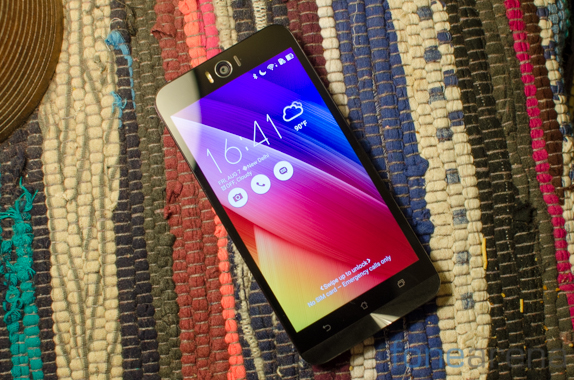
Priced at Rs. 15,999 for the 2GB RAM and 16GB storage variant to Rs 17,999 for the 3GB RAM and 32GB storage variant, we feel that the Zenfone Selfie manages well enough to make a case for itself. More so for the selfie aficionado, the Zenfone Selfie is certainly a device worth considering.

